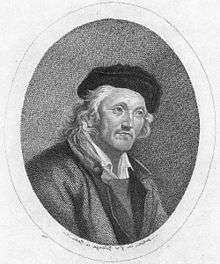Johann Kirnberger
Johann Philipp Kirnberger (also Kernberg; 24 April 1721, Saalfeld – 27 July 1783, Berlin) was a musician, composer (primarily of fugues), and music theorist. He was a student of Johann Sebastian Bach.[1]

According to Ingeborg Allihn, Kirnberger played a significant role in the intellectual and cultural exchange between Germany and Poland in the mid-18th century (Allihn 1995, 209). Between 1741 and 1751 Kirnberger lived and worked in Poland for powerful magnates including Lubomirski, Poninski, and Rzewuski before ending up at the Benedictine Cloister in Lviv (then part of Poland). He spent much time collecting Polish national dances and compiled them in his treatise Die Charaktere der Taenze (Allihn 1995, 211).[2]
Kirnberger became a violinist at the court of Frederick II of Prussia in 1751. He was the music director to the Prussian Princess Anna Amalia from 1758 until his death.
Kirnberger greatly admired Johann Sebastian Bach, deeming him "the greatest of all composers."[3] Kirnberger published Bach's Clavierübungen mit der bachischen Applicatur in the 1760s, and seeking to secure the publication of all of Bach's chorale settings, which finally appeared after Kirnberger's death; see Kirnberger chorale preludes (BWV 690–713). Many of Bach's manuscripts have been preserved in Kirnberger's library (the "Kirnberger collection").
Kirnberger is known today primarily for his theoretical work Die Kunst des reinen Satzes in der Musik (The Art of Strict Composition in Music, 1774, 1779). The well-tempered tuning systems known as "Kirnberger II" and "Kirnberger III" are associated with his name (see Kirnberger temperament), as is a rational version of equal temperament (see schisma). One of his most familiar compositions is Fuga in C-dur für Orgel ("Fanfare" Fugue), which was formerly attributed to Johann Sebastian Bach and then to his son Carl Philipp Emanuel Bach.[4]
References
- Applegate, Celia, Bach and Berlin: Nation and Cullture in Mendelssohn's Revival of the St. Matthew Passion, Cornell University Press, Ithaca and London, 2005, p. 15
- Allihn, Ingeborg (1995). "Ein Richtiges Gefuehl von der Natuerlichen Bewegung"". Johann Philipp Kirnberger als Sammler von Nationaltaenzen, Oschersleben Michaelstein. Ziethen Institut fuer Auffuehrungspraxis. pp. 209–14.
- "Johann Philipp Kirnberger (Composer, Music Theorist, Bach's Pupil)". Bach Cantatas Website.
- "Johann Philipp Kirnberger (1721-1783), Fuga in C-dur für Orgel". YouTube.com.
External links
- More information, including full text, of Kirnberger's Grundsätze des Generalbasses (178?) in the University of North Texas Music Library Virtual Rare Book Room
- Free scores by Johann Kirnberger at the International Music Score Library Project (IMSLP)
- Larry Schou: The Kirnberger Chorales, The University of Michigan School of Music, Theatre & Dance
- https://www.academia.edu/5210832/18th_Century_Quotes_on_J.S._Bach_s_Temperament